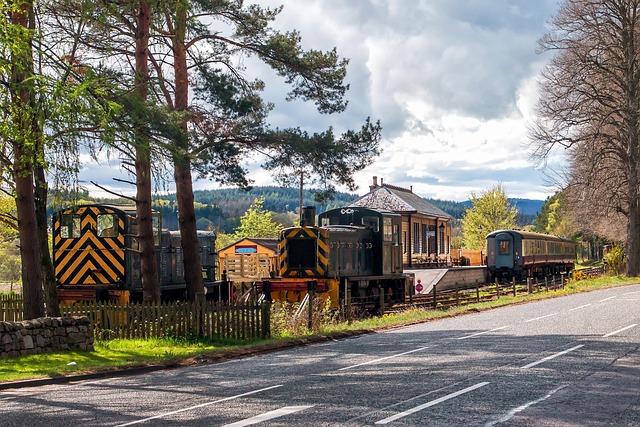In the late 19th century, Lane County, Oregon, experienced rapid transformation due to railroad development, which crisscrossed the region. This led to economic growth by facilitating the transport of goods and people, sparking cultural exchange, and diversifying demographics. The industry boomed local economies in agriculture, logging, and mining, contributing to Oregon's prominence in the American West. This period left a lasting impact on the county's art, literature, and culture, which is now being preserved through community efforts focusing on historic train stations and educational programs.
“The iron horses once rumbled through Lane County, Oregon, forever etching their path into the region’s history and culture. This article delves into the remarkable story of railroad development in Oregon, exploring its profound economic and social implications. From the bustling tracks sprouting diverse communities to its inspiring influence on art and literature, we trace the lasting legacy left by these steel veins connecting towns. Today, efforts to preserve this heritage showcase a region proud of its past, where every artifact tells a tale of progress.”
- The History of Railroad Development in Lane County, Oregon
- Economic Impact: How Railroads Transformed Local Communities
- Cultural Exchange and Diversity Along the Tracks
- Railroads' Influence on Art, Literature, and Music in the Region
- Preserving Lane County's Railroad Heritage Today
The History of Railroad Development in Lane County, Oregon

Lane County, Oregon, has a rich history intertwined with the growth and expansion of its railroad industry. The late 19th century marked a pivotal period when the railway networks began to crisscross the region, transforming it into a vital transportation hub. This period saw the relentless effort of pioneers and entrepreneurs who sought to connect remote areas and facilitate the movement of goods and people.
The development of railroads in Oregon was not just about building tracks; it was a catalyst for immense cultural and economic change. Towns and cities sprang up along the routes, each contributing its unique flavor to the diverse landscape. The railroad brought with it an influx of immigrants, entrepreneurs, and workers, shaping the demography and culture of Lane County. It also spurred the development of agriculture, logging, and mining industries, ensuring Oregon’s place as a key player in the American West.
Economic Impact: How Railroads Transformed Local Communities

The arrival and subsequent expansion of railroads in Lane County, Oregon, brought about a profound economic transformation for local communities. This transformative period sparked unprecedented growth and change, reshaping the region’s landscape. Railroad development in Oregon opened up new avenues for trade, enabling efficient transportation of goods and people across vast distances. The industry created jobs, attracted businesses, and fostered the establishment of thriving towns and cities along its routes.
Local economies boomed as railroads facilitated the export of agricultural products, timber, and other natural resources from Lane County. This increased commercial activity led to the growth of infrastructure, including warehouses, manufacturing facilities, and supporting services. The cultural fabric of these communities also changed, with diverse populations drawn by job opportunities, leading to a vibrant exchange of ideas and traditions.
Cultural Exchange and Diversity Along the Tracks

The Lane County Oregon railroad industry played a pivotal role in fostering cultural exchange and diversity. As trains connected remote communities, they brought together people from diverse backgrounds, leading to vibrant interactions and the sharing of traditions, languages, and cuisines. This exchange not only enriched the local culture but also contributed to a more inclusive and tolerant society. The railroads acted as highways of human connection, accelerating the pace at which ideas, customs, and heritage spread across geographical boundaries.
Railroad development in Oregon facilitated these cultural dynamics by providing a reliable transportation network. Travelers, immigrants, and migrants utilized these routes, leading to the establishment of diverse communities along the tracks. This cultural diversity was reflected in local businesses, festivals, and culinary scenes, making Lane County a melting pot of traditions from around the world. The impact extended beyond borders, as Oregon’s cultural richness became a draw for visitors seeking to experience this unique blend of heritage.
Railroads' Influence on Art, Literature, and Music in the Region

The advent of railroads in Lane County, Oregon, marked a pivotal moment in the region’s cultural evolution, leaving an indelible mark on its artistic and literary landscape. Artists and writers were drawn to the dramatic landscapes transformed by railroad development, capturing the majestic vistas and bustling towns in their works. The rugged terrain and serene beauty of Oregon became a muse for many, inspiring a unique brand of art that reflected both the raw power of nature and the human endeavor of conquest.
Literature flourished alongside these changes, with local authors weaving narratives centered around the railroad’s arrival and its subsequent impact on the community. The rhythm of train journeys inspired poetic verses, while the industry’s growth provided fertile ground for stories exploring themes of migration, commerce, and the ever-changing face of the American West. This cultural synergy between art, literature, and the railroad continued to evolve as the industry expanded, leaving a lasting legacy in Oregon’s rich artistic tapestry.
Preserving Lane County's Railroad Heritage Today

Lane County, Oregon’s railroad heritage is a significant part of its cultural landscape, offering insights into the region’s history and economic growth. Today, efforts to preserve this legacy are more vibrant than ever, as communities come together to safeguard the remnants of the past. Local organizations and historical societies play a pivotal role in documenting and showcasing the county’s railway journey, from its early beginnings to the era of steam locomotives and beyond.
The preservation initiatives include restoring historic train stations, which now serve as cultural centers displaying artifacts and exhibits that tell the story of railroad development in Oregon. These stations also double as community meeting spaces, fostering a sense of connection to the past. Additionally, dedicated groups organize educational programs and events, ensuring that the younger generations appreciate the impact of railroads on shaping Lane County’s identity and its position in the broader Oregon landscape.
